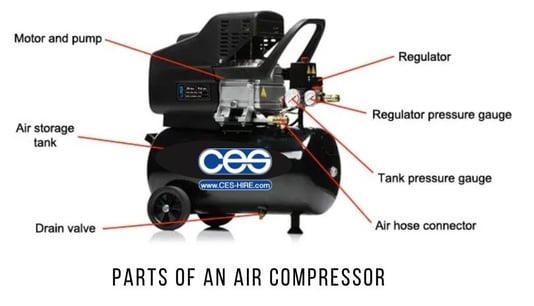As with any machine, your air compressor will need regular maintenance in order to operate at its best. Many of the checks detailed below should be done before each use. The machine instruction manual will provide you with further detail on the specific checks for that model as well as information on how often you should replace parts. Alongside maintenance, your compressor should be serviced at regular intervals which is a something CES can help you with.

Safety First
Quite literally we are putting our safety information first since working with compressed air can be dangerous if not handled with care. As with any machine, ensure you wear the correct PPE (gloves and googles). Remember pressurised air can explode if the tank is punctured so always carefully follow safety points. You must de-pressurise any tools and hoses before connecting or disconnecting. Also, pay close attention to the pressure capability of the tool you are working with and never exceed the pressure stated. Finally, never use an extension cable when plugging in a compressor since this can cause overheating and potential fires.

Pre-use Checks
The following list may look like a lot but once you are familiar with your machine these checks will become instinctive and a daily habit. Here are the elements you should be checking before each use:
- Cooling System: Heat is a by-product of air compression and needs to be removed. This process happens through air cooling via fins on the pump housing or by water-cooling where water is pumped around the water jacket and then removed via a radiator or similar. Always ensure your fins are free from obstructions/dust/debris so the machine can efficiently expel heat.
- Air Intake Filter: This filter should be cleaned/replaced regularly as over time it can become congested. Air is constantly passing through this component to ensure it is clean and will operate your tool most efficiently. Once dirt and debris is caught in the filter, your compressor will have to work harder to pull the air in which causes stress on your machine.
- Tank: Ensure you drain off any condensation or moisture that collects in the tank. As air is pulled in, moisture gathers which reduces the capacity of the tank. You will find a valve on your machine to drain off this excess moisture. Before you open this valve, take care to empty the tank of compressed air first.
- Hoses & Valves: Airlines will certainly wear over time and can become brittle with the constant movement and flex. You may find cracks in your hoses which will leak air consequently your machine must work harder to maintain pressure levels. This again puts unnecessary strain on your compressor.
- Cooling/Engine Oil: This will only be applicable if you use oil for cooling purposes or have a diesel/petrol engine. Just as you would with your car, you should regularly check the oil levels. The oil protects the engine ensuring it is fully lubricated and enabling the compressor to work at optimum levels.
- Drive belt: Rubber belts deteriorate over time and could even snap. Due to their rubber material, they can stretch which causes slipping. This will affect the efficiency of your machine.
Once your machine is examined, you’re ready to go. Why not take a look at our blog giving you tips on operating your compressor.
